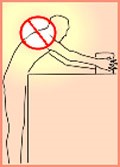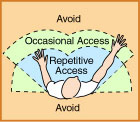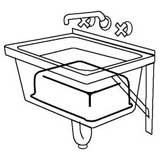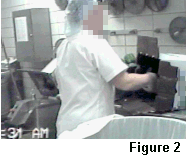Hospitals eTool
Food Services » Work-related Musculoskeletal Disorders



Repetitive Motions:







Hazard
Food Service employees perform many lifting, reaching, and repetitive tasks as part of their job. Strains and sprains may occur during transporting equipment, moving food carts or other heavy carts, pouring liquids out of heavy pots or containers, reaching into deep sinks or containers, and using hand tools. The following risk factors and tasks increase the risk for MSDs:
- Reaching/lifting: Frequent reaching above the shoulders, or elevated, extended reaches for supplies or heavy containers, can cause back and shoulder injury.
- Repeatedly lifting the arms or repeatedly reaching can irritate the tendons or bursa of the shoulder leading to bursitis or rotator cuff tendonitis. Supporting or lifting a load with the arm elevated or extended can lead to injuries such as muscle strain or rotator cuff tears.
- Prolonged or repetitive bending into deep sinks or containers when cleaning/washing small objects contributes to back disorders.
- Repetitive motions: Rapid hand and wrist movements from frequent cutting, chopping, or scooping may lead to hand disorders such as tendonitis, carpal tunnel syndrome, and tenosynovitis.
- Standing on hard floors contributes to knee, hip and back disorders.
- Performing hand-intensive tasks with a bent wrist creates considerable stress on the tendons and their sheaths as they are bent across the harder bones and ligaments that make up the outside structure of the wrist. As the fingers are activated, the tendon slides through the sheath and over the hard parts of the bent wrist, pinching the sheath between the tendon and these hard entities.
- Repetitive finger activations in these postures can create wear and tear on the tendon and the sheath.
- Prolonged forceful finger exertions in these postures can stretch and fray the tendon and create contact trauma to the sheath.
- This wear and tear, fraying, or contact trauma can create irritation and swelling that may lead to tendonitis, tenosynovitis, and potentially carpal tunnel syndrome.
Recognized Controls and Work Practices
Identify and address ways to decrease ergonomic hazards such as:
Reaching/Lifting:
- Provide height-adjustable work surfaces appropriate for the task being performed, so that workers can keep elbows close to the body. For example, use height-adjustable countertops or stands, lower countertops, or provide work stands for employees.
- Redesign or reposition tasks to allow elbows to remain close to the body (e.g., turn boxes on side to allow for easier access).
- Avoid awkward postures. Reposition work in front of worker rather than reaching above or behind to get supplies.
- Use mechanical aids to reduce the need to lift. Use a spring device to automatically lift a load (e.g., use automatic plate and cup riser dispensers).
- Use rolling carts with large, low-resistance wheels that can easily roll over mixed flooring as well as gaps between elevators and hallways.
- Lighten a load that needs to be lifted or get help when lifting.
- Train workers to use proper lifting techniques.
Reaching into Deep Sinks or Containers:
If washing dishes, and using a deep sink, limit excessive reaching and back flexion by:
-
- Placing an object such as a plastic basin in the bottom of the sink to raise up the surface while washing items in the sink.
- Remove objects to be washed into a smaller container on the counter for scrubbing or soaking and then replace them in the sink for final rinse.
Repetitive Motions:
- Rotate workers through tasks that use different parts of the body and different types of tasks or motions so as to lessen exposure to repetitive tasks that affect the same musculoskeletal group(s).Provide sit/stand stools at workstations.
- Provide anti-fatigue mats or shoes designed for prolonged standing and walking on hard surfaces.
- Use mechanical aids for chopping, dicing or mixing foods (e.g., food processors, mixers).
- Select and use properly designed tools (e.g., kitchen scoops or kitchen knives that allows the wrist to remain straight).
- Maintain a neutral (handshake) wrist position.
- Restructure jobs to reduce repeated motions, forceful hand exertions, and prolonged bending.
- Pad the edges of work surfaces that come into contact with the elbow or forearm, which could cause contact trauma.





Additional Information
- Ergonomics. OSHA Safety and Health Topics Page.
- Musculoskeletal Disorders and Workplace Factors - A Critical Review of Epidemiologic Evidence for Work-related Musculoskeletal Disorders of the Neck, Upper Extremity, and Low Back. U.S. Department of Health and Human Services (DHHS), National Institute for Occupational Safety and Health (NIOSH) Publication No. 97-141, (July 1997).
- Inspection Guidance for Inpatient Healthcare Settings. (June 25, 2015). OSHA memorandum establishing guidance for inspections conducted in inpatient healthcare settings.
- Hospital-wide Hazards - Work-related Musculoskeletal Disorders.

